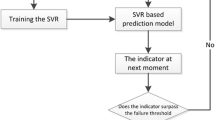Abstract
In order to select the effective health index and build reasonably the prediction model for prognostics, a new approach is proposed. The generative topographic mapping-based negative likelihood probability is used as the health index, and K-means clustering algorithm is employed for state division. The adaptive prediction model based on Markov model and least mean square algorithm is built by the historical data and the online monitoring data. According to the given threshold, the remaining life can be captured. Based on experimental verification, the results indicate that the selected health index is able to effectively reflect the condition of rolling bearings and the proposed model shows high prediction accuracy in comparison to the common one.













Similar content being viewed by others
References
C. Chen, G. Vachtsevanos, M.E. Orchard, Machine remaining useful life prediction: an integrated adaptive neuro-fuzzy and high-order particle filtering approach. Mech. Syst. Signal Process. 28, 597–607 (2012)
A.K.S. Jardine, D. Lin, D. Banjevic, A review on machinery diagnostics and prognostics implementing condition-based maintenance. Mech. Syst. Signal Process. 20(7), 1483–1510 (2006)
N.Z. Gebraeel, M.A. Lawley, A neural network degradation model for computing and updating residual life distributions. IEEE Trans. Autom. Sci. Eng. 5(1), 154 (2008)
N.Z. Gebraeel, M.A. Lawley, R. Li et al., Residual-life distributions from component degradation signals: a Bayesian approach. IIE Trans. 37(6), 543–557 (2005)
J.P. Kharoufeh, D.G. Mixon, On a Markov-modulated shock and wear process. Naval Res. Logist. (NRL) 56(6), 563–576 (2009)
H.E. Kim, A.C.C. Tan, J. Mathew et al., Bearing fault prognosis based on health state probability estimation. Expert Syst. Appl. 39(5), 5200–5213 (2012)
J.K. Kimotho, C. Sondermann-Woelke, T. Meyer et al., Machinery prognostic method based on multi-class support vector machines and hybrid differential evolution–particle swarm optimization. Chem. Eng. Trans. 33, 619–624 (2013)
M.F. Yaqub, I. Gondal, J. Kamruzzaman, Multi-step support vector regression and optimally parameterized wavelet packet transform for machine residual life prediction. J. Vib. Control 19(7), 963–974 (2013)
X. Chen, Z. Shen, Z. He et al., Remaining life prognostics of rolling bearing based on relative features and multivariable support vector machine. Proc. Inst. Mech. Eng. C 227(12), 2849–2860 (2013)
S.S.Y. Ng, Y. Xing, K.L. Tsui, A naive Bayes model for robust remaining useful life prediction of lithium-ion battery. Appl. Energy 118, 114–123 (2014)
D.A. Tobon-Mejia, K. Medjaher, N. Zerhouni, CNC machine tool’s wear diagnostic and prognostic by using dynamic Bayesian networks. Mech. Syst. Signal Process. 28, 167–182 (2012)
Y. Wang, C. Deng, J. Wu et al., Failure time prediction for mechanical device based on the degradation sequence. J. Intell. Manuf. 6, 1–19 (2013)
J. Yu, A nonlinear probabilistic method and contribution analysis for machine condition monitoring. Mech. Syst. Signal Process. 37(1), 293–314 (2013)
C.M. Bishop, M. Svensén, C.K.I. Williams, GTM: The generative topographic mapping. Neural Comput. 10(1), 215–234 (1998)
C.M. Bishop, M. Svensén, C.K.I. Williams, Developments of the generative topographic mapping. Neurocomputing 21(1), 203–224 (1998)
J.A. Hartigan, M.A. Wong, Algorithm AS 136: a K-means clustering algorithm. Appl. Stat. 28, 100–108 (1979)
Q. Liu, M. Dong, Y. Peng, A novel method for online health prognosis of equipment based on hidden semi-Markov model using sequential Monte Carlo methods. Mech. Syst. Signal Process. 32, 331–348 (2012)
Acknowledgments
The work described in this paper was supported by a grant from the National Defence Researching Fund (No. 9140A27020413JB11076).
Author information
Authors and Affiliations
Corresponding author
Rights and permissions
About this article
Cite this article
Zhang, S., Zhang, Y. & Zhu, J. An Adaptive Remaining Life Prediction for Rolling Element Bearings. J Fail. Anal. and Preven. 15, 82–89 (2015). https://doi.org/10.1007/s11668-014-9906-3
Received:
Published:
Issue Date:
DOI: https://doi.org/10.1007/s11668-014-9906-3




